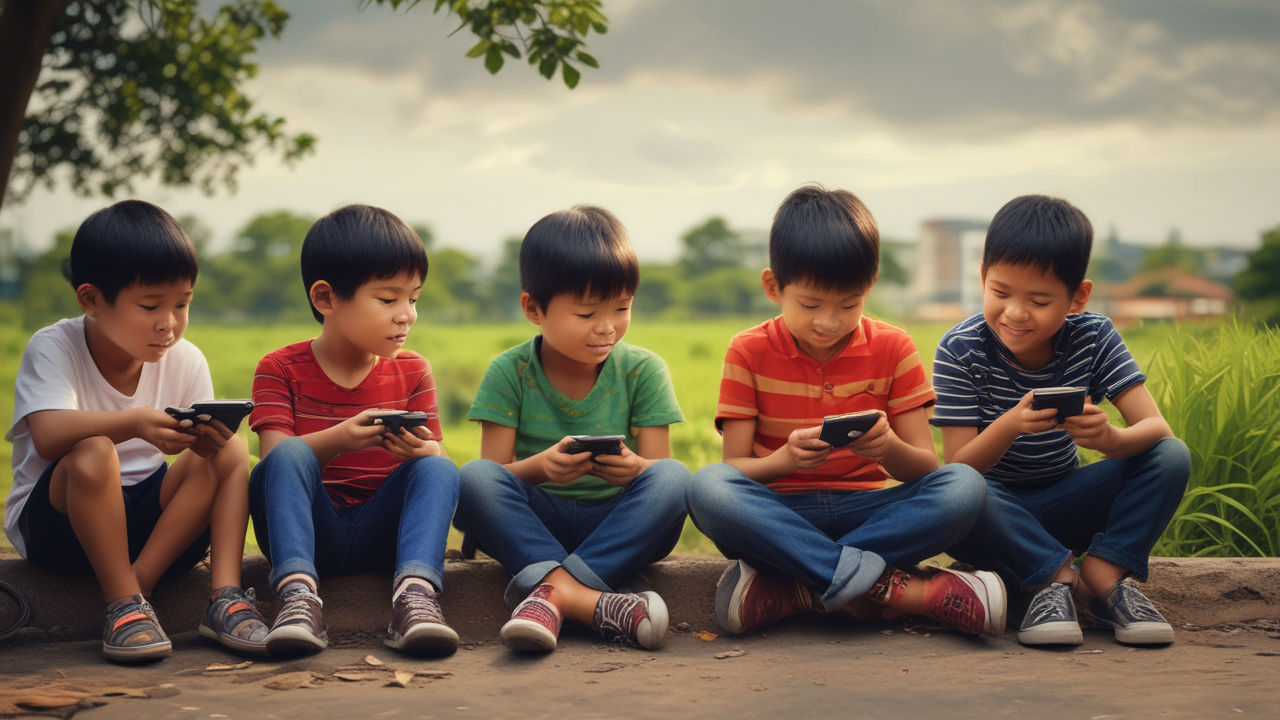Table of Contents
Key Highlights
- “Bocil sotwe” is a trending Indonesian digital slang, blending youth culture with social media trends and meme phenomena.
- The phrase describes young, often elementary school-aged users who engage actively with viral content on platforms like Twitter, TikTok, and Instagram.
- Its popularity raises both cultural excitement and concerns, especially about online safety for children.
- The digital footprint of “bocil sotwe” includes notable accounts and meme-driven communities shaping Indonesian online identity.
- Parental guidance and digital well-being strategies are essential as controversies and public debates surround the trend.
- Understanding “bocil sotwe” is crucial in navigating the evolving landscape of digital childhood in Indonesia.
Introduction
In today’s digital era, Indonesian youth are constantly exposed to new trends and rapidly changing online communities. One phrase that’s come to symbolize this transformation is “bocil sotwe.” Often popping up on social media platforms, this term blends elements of playful internet culture with serious issues around digital childhood. As more kids and teens join these online spaces, understanding what “bocil sotwe” means—and why it matters—is essential for parents, educators, and anyone invested in youth well-being.
Understanding the Meaning of “Bocil Sotwe”
The term “bocil sotwe” is an example of digital slang that’s taken root among Indonesian social media users. In everyday online conversations, “bocil” refers to young children or those acting childishly, while “sotwe” hints at activity centered around Twitter and social media. Put together, “bocil sotwe” describes kids or young teens who are deeply involved in viral trends and meme culture. This phrase became popular as social media platforms evolved, reflecting both the playfulness and risks of digital childhood.
What drove its viral rise? Kids and teens started embracing the identity of “bocil sotwe” as a badge of online belonging, sharing memes, jokes, and dramatic reactions to trending topics. This rapid adoption helped cement “bocil sotwe” as a significant part of Indonesia’s digital vocabulary, but also raised questions about safety, privacy, and community standards.
Origins and Background of the Term
Language evolution in Indonesia has always reflected shifts in cultural and social landscapes. The rise of “bocil sotwe” illustrates how online slang can grow from small communities into mainstream culture. “Bocil” derives from “bocah cilik,” meaning little kid, and is used online to denote youthful energy or inexperience. Meanwhile, “sotwe” is a stylized abbreviation linked to social media activity, especially on Twitter.
The background of this trend can be traced to the explosion of Indonesian youth joining social media platforms. Initial mentions appeared as hashtags and in memes, quickly spreading across TikTok, Instagram, and other networks. The phrase’s popularity grew as young users sought ways to stand out and find camaraderie in digital spaces.
Its evolution from niche slang to internet staple reflects broader changes in how Indonesian youth shape and share their online identities. As the term gathered momentum, it began attracting attention from not just peers, but also parents and educators concerned about its implications.
How “Bocil Sotwe” Became a Viral Internet Phenomenon
The explosion of “bocil sotwe” in meme culture and viral trends didn’t happen by accident. Young users—especially elementary and middle school students—were quick to create and share content featuring exaggerated humor, playful arguments, and over-the-top reactions. These memes caught on, partly because they felt relatable and reflected the everyday reality of digital childhood.
As the phenomenon spread, communities formed around sharing “bocil sotwe” content, often using hashtags to draw attention and drive engagement. The viral nature was fueled by platforms like Twitter, Kwai, and TikTok, which made it easy for trends to go global within hours.
However, the popularity of “bocil sotwe” also raised safety concerns. With more kids posting publicly, risks around privacy and exposure to inappropriate content grew. This prompted debates about where parental involvement and platform moderation should step in—to keep digital childhood as safe as possible.
The Rise of “Bocil Sotwe” in Indonesian Social Media

Platforms in Indonesia have seen “bocil sotwe” skyrocket in popularity, especially in trending content and hashtag-driven communities. The phenomenon is more than a fleeting joke—it’s a marker of how youth culture adapts to and shapes the digital world. Indonesian social media now features countless posts, memes, and influencer campaigns built around the concept.
This surge in activity highlights both the fun and the challenges of online engagement. As we look at how platforms and users contribute to this trend, the next sections will spotlight the major players and the role of memes.
Popular Platforms and Notable Accounts
Instagram, TikTok, and Twitter are at the heart of the “bocil sotwe” movement. These platforms host the most viral content, with key influencers shaping how users interact with the trend. For example, accounts like @mcculloughl on TikTok and Instagram have thousands of followers and frequently share meme-driven, playful posts that fit the “bocil sotwe” style.
Here’s a look at some notable profiles:
| Platform | Username | Followers | Bio |
|---|---|---|---|
| TikTok | @mcculloughl | 2,663 | Consequatur et corrupti est temporibus aliquam inventore. |
| @mcculloughl | 2,662 | Aut odio ratione quis ea fugit. | |
| mccullough1989 | 4,876 | Autem neque et doloremque non rerum. | |
| lmccullough | 2,674 | Vero est aut sit enim voluptatem accusantium sed. | |
| mccullough2009 | 4,902 | Harum quidem et aliquam. |
These influencers fuel the spread of “bocil sotwe” by sharing creative content and engaging with their communities, driving both popularity and conversation.
Role of Memes and Viral Content in Trend Formation
Memes are the lifeblood of the “bocil sotwe” phenomenon, powering its rise on platforms like Twitter and Kwai. Young users design memes that exaggerate typical online behavior, from dramatic reactions to playful banter. These viral creations aren’t just jokes—they act as social glue, helping youth form communities where digital identity is celebrated.
Content sharing accelerates trend formation, with each meme sparking new interpretations and spreading across different networks. A single post can trigger a wave of responses, making the “bocil sotwe” trend highly adaptive. Quote: “Memes have become the language of youth online, shaping how they see themselves and their peers,” says digital culture analyst Elliot Gottlieb II.
This meme-driven culture also has a deeper impact on digital communities, highlighting how humor, creativity, and rapid information sharing redefine social expression for Indonesian youth.
Cultural Impact on Indonesian Youth Communities

The effect of “bocil sotwe” on youth culture is complex, changing how kids and teens relate to one another online. For many, taking part in viral trends and memes shapes their sense of identity and community. However, the phenomenon also raises questions about psychological well-being and online safety.
Social media trends like this serve as both playground and proving ground for young users. The next sections will explore how kids interpret “bocil sotwe” and what it means for their digital persona.
How “Bocil Sotwe” Is Interpreted by Kids and Teens
Kids and teens see “bocil sotwe” as more than just a phrase—it’s a reflection of their online lives and peer culture. Many embrace it as a fun way to interact, posting memes, sharing jokes, and joining viral conversations. This creates a sense of belonging, helping young users feel included in the fast-paced world of social media.
However, there’s a psychological side to this trend. Children who strive to fit the “bocil sotwe” mold might feel pressured to keep up with online standards, sometimes risking their privacy or emotional safety. These social pressures can lead to anxiety or unhealthy competition.
Peer groups often set the tone, encouraging either positive engagement or risky behavior. As kids and young users navigate these waters, it’s crucial to recognize both the excitement and the challenges that come with digital trends like “bocil sotwe.”
The Relationship Between “Bocil Sotwe” and Online Identity
The connection between “bocil sotwe” and youth online identity is significant. Many Indonesian teens adopt digital personas that mirror the playful, meme-centric style of “bocil sotwe.” This social expression lets them experiment, blending humor with self-presentation and engagement.
For some, being labeled a “bocil sotwe” is a mark of popularity within their digital circles. It shows they’re tuned in to the latest memes, trends, and community slang. However, this can also lead to heightened self-awareness and pressure to maintain a certain image.
Viral trends among Indonesian youth hinge on being noticed and accepted online. “Bocil sotwe” acts as a cultural shorthand for digital engagement—where social value is measured in likes, shares, and meme participation. The interplay between identity and trend highlights the evolving landscape of youth communication.
Safety Concerns and Digital Well-being
With “bocil sotwe” gaining traction, digital well-being and online safety are front and center for parents and educators. The rapid spread of content means risks like cyberbullying, privacy breaches, and exposure to harmful material can increase. Ensuring a safe digital environment for young users is more crucial than ever.
The sections below detail practical risks and strategies for keeping kids protected while allowing them to enjoy digital trends responsibly.
Recognizing Risks for Young Users Online
Online engagement with “bocil sotwe” brings several risks that families and communities need to watch for. Young users may face cyberbullying, privacy leaks, or unwanted contact when sharing viral content. Some platforms struggle to moderate harmful material, making exposure more likely.
Key risks include:
- Exposure to inappropriate or exploitative content featuring children.
- Cyberbullying from peers or strangers in meme-driven communities.
- Privacy issues when personal details are posted in public forums.
- Pressure to maintain a certain digital persona, leading to emotional distress.
Kids and young users often interact with trends without fully grasping these dangers. That’s why awareness and proactive management are vital for digital well-being. By recognizing warning signs and understanding the landscape, families can better respond to emerging challenges.
Parental Guidance and Preventive Strategies
Parents play a crucial role in safeguarding children involved in “bocil sotwe” communities. Digital parenting means combining practical controls with open communication to reduce risks and foster safe practices.
Essential strategies include:
- Using parental controls to restrict access to risky platforms or content.
- Discussing online safety and privacy with children regularly.
- Monitoring the apps and social sites kids use, especially those linked to “bocil sotwe.”
- Encouraging children to report anything that makes them uncomfortable.
By staying engaged and informed, parents can guide their kids through digital trends without resorting to invasive oversight. Quotation: “Asking for help and building support networks is a great first step,” says Elliot Gottlieb II, highlighting the need for community in digital parenting.
Preventive measures, combined with awareness, ensure that children can safely navigate viral trends while exploring their online interests.
Criticisms and Controversies Surrounding “Bocil Sotwe”
No viral phenomenon is without its critics. “Bocil sotwe” has sparked public debate in Indonesia, with concerns over its impact on youth culture, the spread of inappropriate material, and the trivialization of serious issues. Some argue that the focus on memes and digital slang encourages shallow engagement, while others worry about the safety of young users participating in the trend.
As conversations around “bocil sotwe” continue, the next sections explore community reactions and how families and influencers respond to challenges.
Negative Reactions and Debates in the Community
Backlash against “bocil sotwe” has emerged from both online communities and concerned adults. Critics highlight how the trend sometimes promotes immaturity or distracts from more meaningful discussions. The spread of risky content has led to heated debates about moderation and responsibility on social platforms.
Social discourse often centers on whether “bocil sotwe” is harmless fun or a gateway to more serious problems. Public debate frequently pits youth advocates against those calling for stricter oversight of meme and viral content. “Are there any controversies or criticisms surrounding the ‘bocil sotwe’ trend online?” Yes—especially around the potential for exploitation and normalization of risky behavior.
As with any online movement, the controversy reflects broader tensions between creativity, freedom, and safety in digital communities.
Responding to Criticism: How Influencers and Families Adapt
Influencers and families have begun to adapt in response to criticism of “bocil sotwe.” Many prominent social media figures now advocate for safer practices and educate their followers about online risks. They use their platforms to promote positive engagement and discourage harmful behavior.
Families, on the other hand, are working to strengthen support networks and foster open dialogue with their children. Some seek guidance from local authorities or organizations like the KPAD to navigate tough situations and access resources.
Adaptation is key—whether it’s revising content strategies, implementing stricter privacy controls, or simply listening to young users’ concerns. The ongoing conversation around “bocil sotwe” demonstrates the importance of balancing fun and safety, ensuring that digital childhood remains empowering rather than dangerous.
Conclusion
In conclusion, “Bocil Sotwe” has transcended its origins to become a significant phenomenon in the digital landscape for Indonesian youth. While it allows children and teens to express their online identities, it also poses safety concerns that cannot be overlooked. Parents play an essential role in guiding their children through this digital world, ensuring they engage with content like “Bocil Sotwe” safely and responsibly. As we navigate these viral trends, it’s crucial to strike a balance between enjoying this cultural moment and prioritizing our children’s well-being. If you’re looking for more insights on digital safety and engagement for your child, don’t hesitate to reach out for a free consultation.
Frequently Asked Questions
What does “bocil sotwe SD” mean and how is it different?
“Bocil sotwe SD” refers specifically to elementary school-aged children engaged in digital trends, often highlighting content that’s more sensitive or inappropriate. Unlike the broader “bocil sotwe” label, the SD variant raises greater concerns in online communities due to its focus on younger, vulnerable users.
Are there any celebrity figures linked to “bocil sotwe”?
Celebrity involvement in “bocil sotwe” is mostly seen through influencers and viral accounts on Instagram, TikTok, and Twitter. While mainstream celebrities are not directly tied to the trend, prominent accounts and online personalities have played a major role in shaping its reach and impact.
How can parents help ensure safe digital engagement for their children?
Parents can foster safe digital engagement by setting clear rules for internet use, monitoring their child’s online activity, discussing privacy and cyber risks, and using parental control tools. Regular conversations about digital trends like “bocil sotwe” help children navigate online communities safely and confidently.

